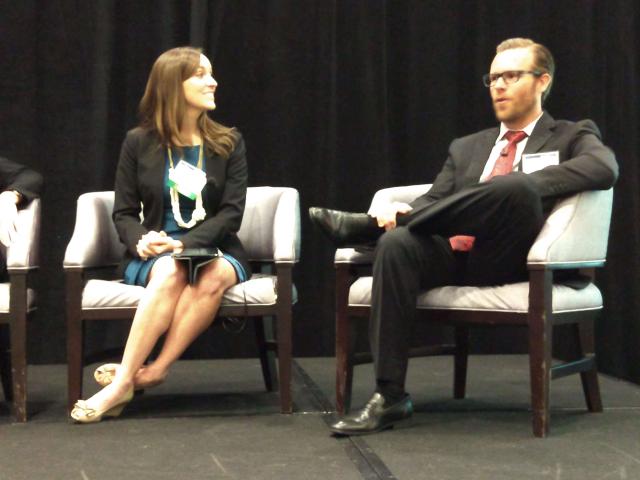
Highlights from The Life Science Economic Development Summit

The Life Science Economic Development Summit
On Monday, April 30, economic developers, educators and elected officials from across the state gathered in downtown Raleigh to discuss attracting and growing the life science industry in North Carolina. Hot topics at this year’s Life Science and Economic Development Summit included:
• How the state can attract life science companies to rural parts of the state
• What companies need when they launch or relocate their business
• How other states are successfully attracting life science companies to their states
Below are some highlights from the Summit.
View our Google Photos album, and add some of your own.
Session: Getting Specific: The Precision Life Science Boom
As gene therapy grows and companies pursue and gain FDA approval, the precision life science presence in North Carolina continues to grow. According to Kate Holt, Ph.D., NCBiotech’s Senior Director, Investments, as new gene therapies have been introduced, the FDA has shown a willingness to be nimble, adapting its processes to help bring gene therapies to market.
When asked the importance of place to a precision science company, Falcon Therapeutics CEO Susan Nichols said, “What I find in the Triangle is a community. It is a place where everything is a phone call away. People have paved the way. I just have to reach out. Here we have a labor pool and facility space We can find everything we need in the community.”
When Bluebird Bio was seeking a location for its manufacturing facility, it found what it needed in the Triangle. “We chose the Triangle for three reasons, the location, talent and access to universities,” said Bluebird Vice President Tom Leitch. “We need world-class talent, and we just didn’t see it in other regions. We see it here.”
Session: Beyond the Mega Cluster
How have rural areas grown life sciences in their communities?
“You have to take advantage of assets both natural and manmade and find out what is your advantage from an economic development aspect,” said panel moderator and Biltmore Farms President Jack Cecil.
For George Briggs, executive director of the North Carolina Arboretum, he changed his vantage point.
“It became imperative to me to see the arboretum differently,” said Briggs. “I needed to look at it as a place for innovation."
Panelist Jennifer Lantz, executive director of the Wilson Economic Development Council, pointed out that many companies are experiencing transformation, and, as a result, have unique needs. However, there is one need that continues to emerge: water.
“Water is the single most critical factor to attracting biopharma manufacturing,” said Lantz. “You have to have quality water.”
She also stressed that economic developers have to be on their “game” all of the time.
All of the panelists agreed: partnerships are key to success.
“I will play in the sandbox with anybody,” said Lantz. “We are all partners, competitors and allies.”
Briggs agreed.
“You can’t have too many partnerships,” he said. “You need partners that can be in it for the long haul.”
Session: The Secret Sauce for Life Science Growth
What are the building blocks a community needs to attract life science companies? For Pete Pellerito with the Biotechnology Innovation Organization, following are the critical building blocks:
1. Capital
2. Workforce
3. Technology transfer with research universities
4. Physical infrastructure
5. Public/private partnerships
Each panelist emphasized the importance of these building blocks.
In Illinois, state economic developers realized that many companies were leaving the state to work with universities on the east and west coasts. It’s solution? Create an incubator that brought industry together with university researchers. Today, there are more than 10 incubators throughout the state.
In Colorado, the state brought together educators and industry to ensure companies’ workforce needs were supported by curriculum in high schools and community colleges.
Pellerito also reminded attendees that life science companies are often small, making their needs different. In Illinois, universities were not interested in small companies. However, they learned the important work these companies were doing. Today, the state’s universities are running fellowship programs for graduate students, and every university has incubators on campus.
Session: Looking Through the Lens of a Site Selector
Panelists on the Site Selector session agreed that life science companies have different needs.
“The future of life science is moving away from big manufacturing,” said Sarah Raehl, senior manager with Deloitte Consulting. “Life science manufacturing’s needs today are highly customizable with a small footprint. Now communities with smaller infrastructure can bid. We are just now seeing this trend take off.”
Panelists agreed that North Carolina can build on its success with life science companies by showing flexibility and creating programs that encourage growth.
Site recruiter Woody Hydrick, managing principal with Global Location Strategies, also emphasized the changing workforce. He pointed out that employees must be specialized as the number of jobs at a site decrease, the capital investment increases.
Also Heard at LSEDS:
Chris Chung, CEO, North Carolina’s Economic Development Partnership
“It is amazing the number of deals NC gets to bid on. The key of course is how do we continue to compete for the opportunities we get. “
